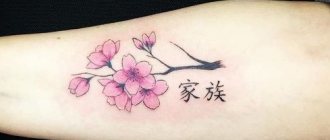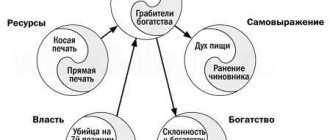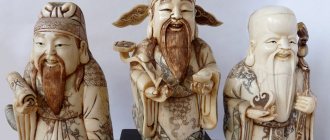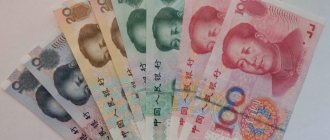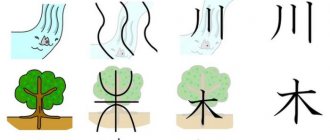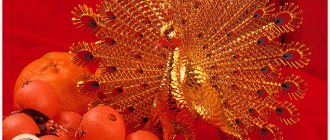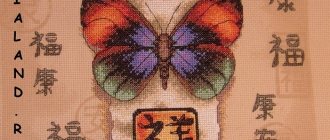On the eve of the Chinese New Year, various traditional holiday attributes appear on supermarket shelves, among which you can see red envelopes with wishes for prosperity. Red hongbao (红包, hóngbāo) envelopes are the most popular way to give a gift in China. Money is invested in such envelopes and presented to relatives, friends, newlyweds at weddings, and traditionally in organizations employees are given a holiday bonus in such envelopes.
Red envelopes are not just money, they are also a wish for well-being and prosperity. Red is the most popular and auspicious color in China, it symbolizes good luck and happiness. The envelopes are decorated brightly, congratulations are often embossed with large gold hieroglyphs.
Origin and meaning of the red hongbao envelope
In ancient times, there was a certain little demon called Sui 祟. He emerged from his underground lair on New Year's Eve and went into settlements to harm children. Sui touched the sleeping child's head with his hand, and the baby's temperature rose, after which he began to delirium. And when the temperature subsided, the child could turn into a weak-minded person.
Therefore, in order to prevent the machinations of the demon, people did not sleep on New Year's Eve, they lit candles and sat all night by their child's bed.
Once, one married couple, on the night before the New Year, strung eight copper coins on a red thread to play with their son, thus preventing him from sleeping, but the baby still fell asleep. Then the parents did not wake him up, but decided to guard their son’s sleep themselves, praying near his bed, but unbeknownst to themselves, they also fell asleep.
But God heard their prayers and sent eight fairies to protect the family; the fairies turned into coins lying under the baby's pillow.
Suddenly a strange wind arose, opened the doors and windows, and even the candle flame went out. The evil demon Sui appeared. Just as he was about to reach out and touch the child's head, eight rays of golden light suddenly burst out from under the pillow and the demon jumped out of the window in horror.
The news of this incident quickly spread first throughout the village and then throughout the country. People realized that when parents sincerely pray, God sends eight guards who, under the guise of coins, protect their children. Therefore, people began to string eight coins on a red thread and put them under children's pillows. Since then, this has become an annual custom, and the Sui monster no longer appears.
Such envelopes with money began to be called “yasuiqian (压岁钱)”, that is, money that protects against Sui.
The demon's name Sui (祟) sounds the same as the word for "year" (年) - "sui". Over time, the hieroglyph for the name of the demon in the word “yasuiqian” was replaced with the hieroglyph for “year.” And over time, coins were replaced with paper bills, and thread with envelopes.
Accessible Feng Shui
Many who are interested in Feng Shui practices know how red envelopes help in attracting and increasing money and general well-being. But few people know “how they work” and what (except for red color) these envelopes should and can be...
I want to talk to you about this in more detail: So, let's start with color, why is the envelope red and not blue or green?! And all because the red color has powerful Yang energy. In the East, it is believed that it is the (male energy) “Yang” that is capable of strength, power, attracting wealth and influencing. The bright energy of red revitalizes the process of changing the situation in a positive direction. And during the reign of the Qin dynasty, coins were tied with a red thread (this tradition has survived to our times, although now these coins with red ribbons have more of a decorative and magical function and are not used as money), it was believed that in this way their owner became untouchable for evil spirits and vice versa acquired prosperity and health.
In addition to red (the most common color), gold color (the color of gold, wealth and capital) is also used for money envelopes. Since ancient times, this color has been endowed with strong properties (it is believed that it is able to activate the energy around itself, and money in particular.)
According to Feng Shui traditions, money should be placed in a red envelope, as well as in a wallet, in a certain form and order - clean bills without bent corners, from the smallest bill to the largest, face up. The energy of money is very subtle and requires not admiration, but respectful attitude! Such envelopes should be stored in the wealth zone of your home, which is usually located in the southeast of your home.
The envelope itself is already a cozy home for money, but if you put it, for example, in a red box, this can double the effect of attracting money energy.
There are several types of envelopes:
— Cash envelope with various symbols:
*** Envelope - /WEALTH/ - this is a savings envelope, they report and save in it, and the more money accumulates there, the more powerful its power as a talisman becomes. (It is advisable not to take money from it for small needs.)
****Envelope - /PROSPERITY/ - this is a negotiable envelope for current expenses, from which you can take and report.
*** Envelope - /JUSTICE/ - is used for money intended for the distribution of debts, and is also often used by small business owners to issue salaries and fulfill obligations to their wards.
- Envelope ***Envelope - /FU LU SI/ (in honor of the three star elders - about whom I already wrote.) - this envelope is considered universal, by purchasing this envelope you can hope for good luck in all areas of life - career, longevity and health, good luck in everything.
— Ritual envelope (this is the second type of envelope) Its main feature is filling the envelope with a magical ritual, by completing which you can achieve your cherished goal. In order to clearly understand the essence of the “ritual envelope,” I will tell you about the one I have.
My ritual envelope is called “TO ATTRACTION CLIENTS”
In terms of the density of the paper, it is very hard (made conscientiously so that it will last throughout the entire ritual). Various symbols are brightly and colorfully drawn on the envelope: CAO SHEN (god of wealth, increasing happiness) - he helps in business and trade, gives an advantage in business and protects from the machinations of competitors. The reverse side of the envelope depicts SAILBOATS SAILING AROUND A HUGE COIN - as a symbol of growing luck, wealth and profits coming from various sources. ANCIENT CHINESE COIN OF HAPPINESS - as a symbol of protection, good luck, abundance. It is believed that when you have this talisman, you are surrounded by positive energies. which contribute to the implementation of the plan. BUNDLE OF HAPPINESS COINS - three coins connected with a red thread, which provide an increase in well-being. The ligament radiates power that fills with activity your intentions to invite abundance and prosperity into your life. The envelope contains two inserts (two red thick cards with an image of a special hieroglyph on the outside, which means attracting clients). Each card must be activated with your energy, after having entered into it your name and type of activity (position), you can write a specific wish - “how much it’s you who want clients per month.” One such insert should be placed in a place where you can see it (preferably on your desktop) so that your eyes are always in contact with it. Place the second insert (with the same writing) in your wallet or bag, so that your intention to “have more clients” is always with you and with you. On a favorable day on the waxing moon, start the ritual by depositing some of the money received from the client. Determine one bill (100,500,1000,5000 rubles), which you will continue to use in the ritual, putting it in a magic envelope from each of your clients. Think about what status or symbolic item you would like to purchase - as a symbol of your success, it would attract the eyes of buyers and at the same time serve as a decoration for your office or your desktop. (For example, a Mobile, a crystal globe or a beautiful papier press...) Collect so much money so that you have enough to buy exactly this thing you have in mind (when you collect, mentally imbue your future purchase with the energy of success and magic) Do not spend the money you have set aside for other purposes. Hide the envelope in the south-eastern square of your office or in the front (water) palace at home or at work. When the amount you need has been collected, buy the desired talisman, get comfortable and do a meditation (think about how many clients you would like to have per day, what and in what quantity they will buy, what qualities they have.) The more specific your request is, the more accurately the universe will give result, so don’t be lazy at this stage of the ritual. EVERYTHING - now your powerful magnet - talisman is ready and will attract the right clients to you, who will increase your well-being and monetary luck. But of course, in addition to this ritual envelope, there are many others, such as, for example: - TO FULFILL WISHES.
- TO FIND LOVE. — FOR SUCCESSFUL EDUCATION, etc.
In addition to the independent use of red magic envelopes, in the East it is considered very favorable to give money in these envelopes (since giving money in our time is not an uncommon gift). In this way, you will not only give the recipient the opportunity to increase their finances, but also strengthen the energy of cash flows around you, so the benefits will be double. But always remember that the “money envelope” is one of the “amplifiers” of your intentions and thoughts, so it will be effective if you believe in yourself and in your ability to attract wealth and luck.
If you love Feng Shui talismans, know how to use them!
How much money should you put in the red envelope?
How much should you put in an envelope so as not to offend the recipient? For some, this dilemma can be a real headache.
It all depends on your income, which will determine the thickness of the envelopes you hand over. On average, in large cities the following amounts are donated:
- Senior people (parents and grandparents): 500–2000 yuan;
- Teenagers (schoolchildren and students) (relatives and colleagues, children of close friends): 50–200 yuan;
- To your children: from 100 yuan and up to the amount you deem necessary;
- Employees: 100–1000 yuan (awarded on the last working day before Chinese New Year);
- Other children: 10 or 20 yuan.
The closer the family ties, the higher the amount of the gift; for the closest ones it can reach up to 6,000 yuan.
Tax amount depends on income
Income tax for individuals can range from 0 to 45% depending on the size of the salary. Thus, Chinese with a monthly income of up to 4,000 yuan (that’s almost $620) are exempt from paying personal income tax. And with a salary of more than 100,000 thousand ($15.5 thousand), the employer will withhold 45% tax from them. This applies only to salary, this does not include bonuses, bonuses from the employer, and so on.
China also has an income tax for foreigners who work or do business in China while staying in the country for more than 183 days a year. It is 5% of income.
In general, China has a progressive tax model, with many tax incentives for businesses and excellent tax conditions in developing areas.
What to Avoid When Giving Red Envelopes
Since the Chinese are very superstitious, you may wonder what amount would be considered auspicious. The amount of money contained in the envelope must end with an even number; odd amounts of money are traditionally associated with funerals. The exception is the number 9 (九), since it is a homophone to the word long (久) and is also the largest number.
In some regions of China, odd numbers are preferred for weddings because they are difficult to separate.
There is also a widespread tradition that the number 4 should not be present in the sum, for example, 40, 400 and 444 etc., since the pronunciation of the word four (四) is a homophone to the word death (死).
In the northern region of China, even number sums such as 100, 200, 500, 800 and 1000 are popular, while sums such as 250, 400 or 740 should be avoided. In the south of the country, people will send packages of money worth 88, 666, 888 or 999 yuan as these numbers are considered favorable. Such numbers usually mean wishes for prosperity and smooth development.
It is also important to put new, crisp banknotes and no coins in the envelope, which is why many Chinese are forced to stand in line at the bank before the New Year.
You still have to pay for the birth of a second child, but there are exceptions
Probably the most high-profile tax in China is the birth tax, which is popularly called “one family, one child.” Despite the fact that the relevant law on fines has already been repealed, and a Chinese family may well have several children, many are in no hurry to do this precisely because of the large tax of 50 thousand yuan (that’s almost 580 thousand rubles).
Exceptions include national minorities or those who are the only child in the family. They may not pay this tax.
Etiquette when receiving a red envelope
When you receive a red packet, you must first thank the giver and express your blessings to him. It is impolite to immediately open an envelope and check the amount inside, which is contrary to etiquette in Western countries, where gifts are opened immediately. If you do this, the givers will feel awkward.
When someone gives you lucky money, you shouldn't give them your package right away in return. It will feel like a simple exchange, but not like a holiday gift.
Almost everything in China is paid using WeChat and QR codes
Cash is rarely used in China; almost everything is paid electronically, mainly using the WeChat app. Initially, the service was created as a messenger, but quickly turned into the most important Super App and became an indispensable part of life. If you come to China, you can do without a lot, but definitely not without WeChat.
In this application, they not only communicate, but also perform almost all routine financial transactions: pay any bills, open electronic wallets, link cards for purchases, do charity work, make appointments with doctors and find personnel for work.
Image source: wechat-ru.ru
Contactless payment by card or Apple Pay is not as common in China as in Russia. Instead, almost any purchase can be made by scanning a QR code using WeChat (or Alipay - another common Chinese payment system).
Electronic red envelopes
During the 2014 Lunar New Year holiday, instant messaging service WeChat introduced the ability to distribute virtual red envelopes containing money to contacts and groups through its mobile payment platform. This feature immediately became very popular, with billions of virtual envelopes now being sent during the Chinese New Year holidays.
WeChat (微信, Wēixìn, literally “micromessage”) is a mobile communication system for sending text and voice messages, developed by the Chinese company Tencent, the first release was released in 2011.
And now, thousands of years later, even in the digital age, the Chinese still continue the good tradition and red envelopes still bring happiness to both children and adults. After all, this is a manifestation of love and gratitude to each other.
The cost of a metro ride can reach up to 400 ₽
China has excellent public transport. These are mainly metro and buses.
Subway fares may vary depending on the distance you need to travel. Translated into rubles, a trip can cost from 80 ₽ to 400 ₽. Usually everything is calculated using local metro transport cards or the WeChat program. The metro has luxury cars (there are a small number of passengers and there is no crowding), but travel in them costs three times more.
The metro lines can be very confusing, so when traveling, it is best to use the Shenzhen app (iOS/Android), which provides the most convenient route. The application works in 14 languages, including English and Russian.
Before entering the metro, you need to prepare for a thorough security check - it is almost the same as at the airport. It should be taken into account that you will absolutely not be allowed on a Chinese metro train with any container for liquid in your hands.
Buses are the cheapest form of transport in China, but also the slowest. The cost of travel within the city ranges from approximately 30 ₽ to 100 ₽.
To get around faster and avoid traffic jams, many Chinese people prefer electric motorcycles. Their prices are completely different: you can buy a used one for 1,500 yuan ($232), or you can buy one in a showroom for tens of thousands. Electric motorcycles charge quickly and are inexpensive. At the same time, in China there is such a service as motorcycle taxi. That is, you can simply catch a motorcycle on the road (naturally, this is an unofficial taxi, but at the same time it is very common and many people use it). A trip around the area, converted to Russian rubles, will cost approximately 80–150 rubles. You can ride a motorcycle on a separate path, which reduces travel time. However, many areas in cities prohibit motorcycles to prevent them from interfering with pedestrians, so you can't drive everywhere.
Most expressways and roads connecting cities have tolls. Prices depend on the travel distance and range from approximately 100 ₽ to 800 ₽. In some provinces, there are toll roads inside cities; they make it possible to reduce travel time and avoid traffic jams.
